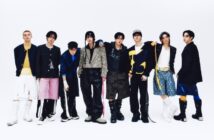
Kpop has hit the The Guardian once more, the newpaper and news site fast becoming popular with Kpop fans across the UK. In this latest article, writer Edwina Mukasa details the recent successes of Kpop and what makes it so unique. The newspaper of the article will be on sale tomorrow, the 16th of December 2011. Check out the online article below the cut.
The biggest surprise at last month’s MTV European Music awards didn’t come from the outfits chosen Lady Gaga, or that weird naked man roaming around the stage . In fact, the most unexpected moment arrived towards the end of the ceremony, when the winner of best worldwide act award was announced. The winners of the fan-driven award were Korean group Bigbang , who won 58m votes to beat Britney Spears. This was the one act that night most viewers wouldn’t have known.
Bigbang’s victory shed light on the rise and rise of Korean music across Europe. Korean pop – K-pop for short – has become one of South Korea‘s most notable exports in recent years. Paul Han, co-founder of the South Korean pop culture blog Allkpop.com , defines the style as “fun music, with a fusion of many genres” – it takes in electro-driven bubblegum pop; sometimes it’s sprinkled with semi-nonsense English lyrics; sometimes there’s an added R&B sway. Its audience is largely female, from early teens through to late 20s. “K-pop, I think, is personality,” says the Korean-Canadian singer G.Na . “It’s very melodious, very easy to sing along to.”
Since Allkpop.com launched in 2007, Han has seen a consistent growth in its European readership, reflecting K-pop’s spread from its homeland. “When we first opened our blog, the Europeans made up maybe 1% of the readers,” he says. “Now it’s close to 25%.” That spread has been noticed by the big corporations: iTunes started selling K-pop to European audiences early in 2010, and Google is planning to set up up a K-pop channel .
This past year has already seen several major K-pop events in the west, with the SMTown World Tour – featuring Super Junior , TVXQ and Girls’ Generation – selling thousands of tickets for shows in Paris, Los Angeles and New York. SHINee played the UK’s first ever K-pop show at the opening of the London Korean film festival earlier this autumn, and at the start of this month the Brixton Academy in London hosted the United Cube Concert, with a bill made up of acts on the Korean label Cube Entertainment , with fans paying up to £65 a ticket.
The spread of Korean pop culture – a phenomenon nicknamed hallyu, or Korean wave – has been driven by TV, but not by the reality shows that are breeding grounds for UK manufactured pop. Instead, drama has been the vehicle to bring K-pop to new audiences. The process started with What Is Love All About, which was shown on Chinese state TV in 1997, and which sparked a wider interest in Korean TV and music across east Asia. At the same time, the Korean boy band H.O.T. (which stands for High-five of Teenagers) found a big audience across the region with hits We Are the Future, Candy and Warrior’s Descent. They had been put together by the SM Entertainment company in 1996, and their success – they even had their own brand of soft drink at their peak – provided a template for future K-pop bands. Their international success was followed by BoA – the female artist Kwan Boa, whose stage name stands for Beat of Angel – who sold 1m copies of her Listen to My Heart single in Japan in 2001.
The big breakthrough, though, came with the show Winter Sonata in 2003, which was shown in Japan, Taiwan, Thailand and the Philippines. With the rise of YouTube, subsequent dramas were able to spread further in a second Korean wave – Boys Over Flowers , launched in 2008, now has dedicated viewers around the world, both through the web – with fans uploading and subtitling episodes – and on TV stations as far afield as Kazakhstan and Peru. As Jae Kim of the Korean TV network MBC explains: “Before the internet, many fans had very little access to K-pop. You only would really have access by visiting Korea. The internet created accessibility.” Now countless fan sites draw attention to every piece of news, now matter how minute, from Korean TV and music.
K-pop has benefited from the rise of these dramas, because music is a key part of these shows. SHINee’s Stand By Me , for example, featured heavily in Boys Over Flowers. Key songs are repeated in Korean dramas, giving them exposure every bit as potent as a video in heavy rotation. When SHINee played in London, for example, though Stand By Me was not included on their setlist, it was repeatedly played through the PA to deafening cheers from fans who’d travelled from across the UK and Europe to see the band. Those fans in Leicester Square testify to the power of the TV dramas in drawing them into the music, and to the fan-driven nature of its spread: “A lot of my friends were watching [the show]You’re Beautiful, and suggested that I watch it and listen to [the group]F.T. Island, and it just started from there,” says 17-year-old Londoner Jessica.
The result, according to a survey conducted by the Korean Culture and Information Service, is that there are an estimated 460,000 Korean-wave fans across Europe, concentrated in Britain and France, with 182 hallyufan clubs worldwide boasting a total of 3.3m members.
The Korean Connection, based in Paris, is a hallyu fan club with 4,000 members, established with the backing of the state-run Korean Cultural Centre, which arranges K-pop club nights, dance classes, and trips to Korea, and spreads the word about K-pop through social networking sites. Maxime Paquet, its president, sees K-pop’s strength as being its refusal to stand still. The average K-pop event, he says, is “close to what we can call ‘total entertainment’ … K-pop is not only music, but a complete show. K-pop groups are managed by smart entertainment companies that invest a lot in artistic innovation. Every month, new groups appear and disappear.”
K-pop’s fans use the internet as if they were a campaigning group. When the SMTown tour’s sole Paris date sold out in minutes this summer, fans organised a flash mob in front of the Louvre to demand a second date be added, with Facebook and Tumblr communities adding their voices to the mix. Freya Bigg, who runs the UK-based blog UnitedKpop.com, helped organise similar flashmobs in London’s Trafalgar Square to demand shows from her preferred K-pop acts. “They’re a great way to get the attention of the Korean media – it shows the dedication of fans here in the UK. They’re also a great way to connect fans and find more – imagine thinking that you’re the only fan around and then you see a flashmob in town.”
The level of hysteria now the K-pop acts are finally coming to London is comparable to any X Factor live show. “United Cube London means so much to me,” exclaims a breathless Li Suhaimi, from east London, who says she’s followed the band Beast – on the Brixton bill – “through several time zones. I’ve travelled to Seoul, Thailand and Singapore to see them.”
So, how does K-pop grow in the West from here? Can it make the transition from being an internet-based phenomenon, with a self-selecting if hugely active fanbase, to crossing over into the mainstream media? Was BigBang’s win at the European Music awards the shape of things to come, or just an indication of how well-organised those fans are – in short, was it K-pop’s Belle and Sebastian at the Brits moment? Simon Hong, the CEO of Cube Entertainment, the label whose bands came to London a couple of weeks ago, is optimistic but cautious: “The show in Brixton is a good opportunity for this part of the world to get a glimpse of our high-level artists in Korea. But there’s a lot more work to be done, so K-pop is just on the starting line.”
Check out the original article here.
What do you think guys? We think it was probably the best Kpop article from them yet, not to mention our shout out! Leave your thoughts in the comments section below and don’t forget to pick up a copy of the newspaper tomorrow!




